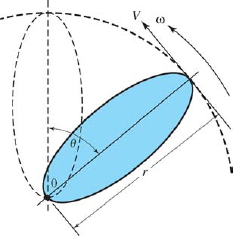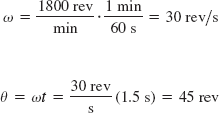14.3. Uniform Circular Motion
14.3.1. Angular Velocity
Let us consider a rigid body that is rotating about a point O, as shown in Fig. 14-20. The angular velocity is a measure of the rate at which the object rotates. The motion is called uniform when the angular velocity is constant. The units of angular velocity are degrees, radians, or revolutions, per unit time.
Figure 14.20. Rotating body. The symbol ω is lowercase Greek omega, not the letter w.

14.3.2. Angular Displacement
The angle θ through which a body rotates in time t is called the angular displacement. It is related to ω and t by the following equation:
NOTE
![]()
The angular displacement is the product of the angular velocity and the elapsed time.
This equation is similar to our old formula (distance = rate × time) for linear motion.
Example 23:A wheel is rotating with an angular velocity of 1800 rev/min. How many revolutions does the wheel make in 1.5 s? Solution: We first make the units of time consistent. Converting yields
Then, by Eq. 1026, |
Example 24:Find the angular velocity in revolutions per minute of a pulley that rotates in 0.750 s. Solution: By Eq. 1026, Converting to rev/min, we obtain |
|
TEACHING TIP: ... |
Get Technical Mathematics, Sixth Edition now with the O’Reilly learning platform.
O’Reilly members experience books, live events, courses curated by job role, and more from O’Reilly and nearly 200 top publishers.


